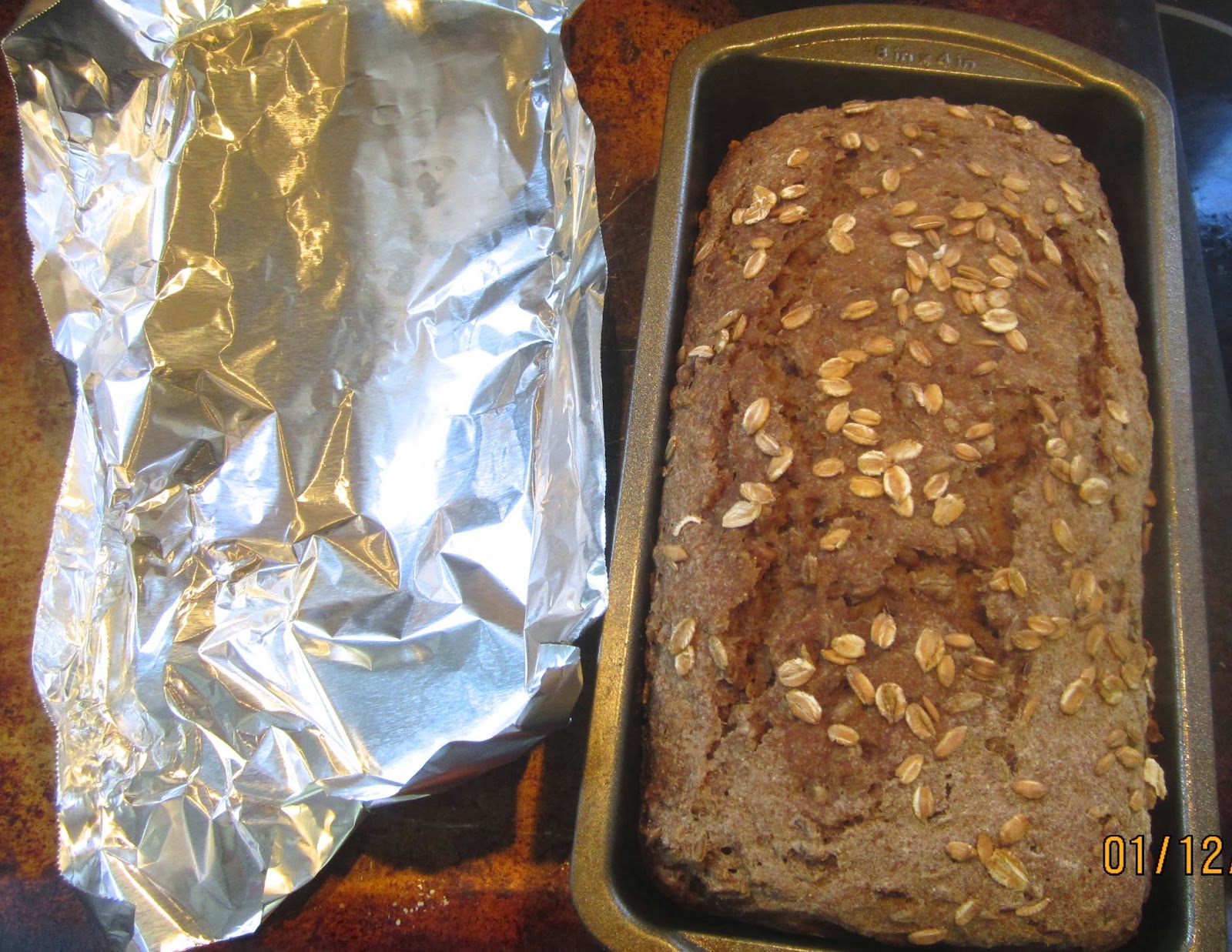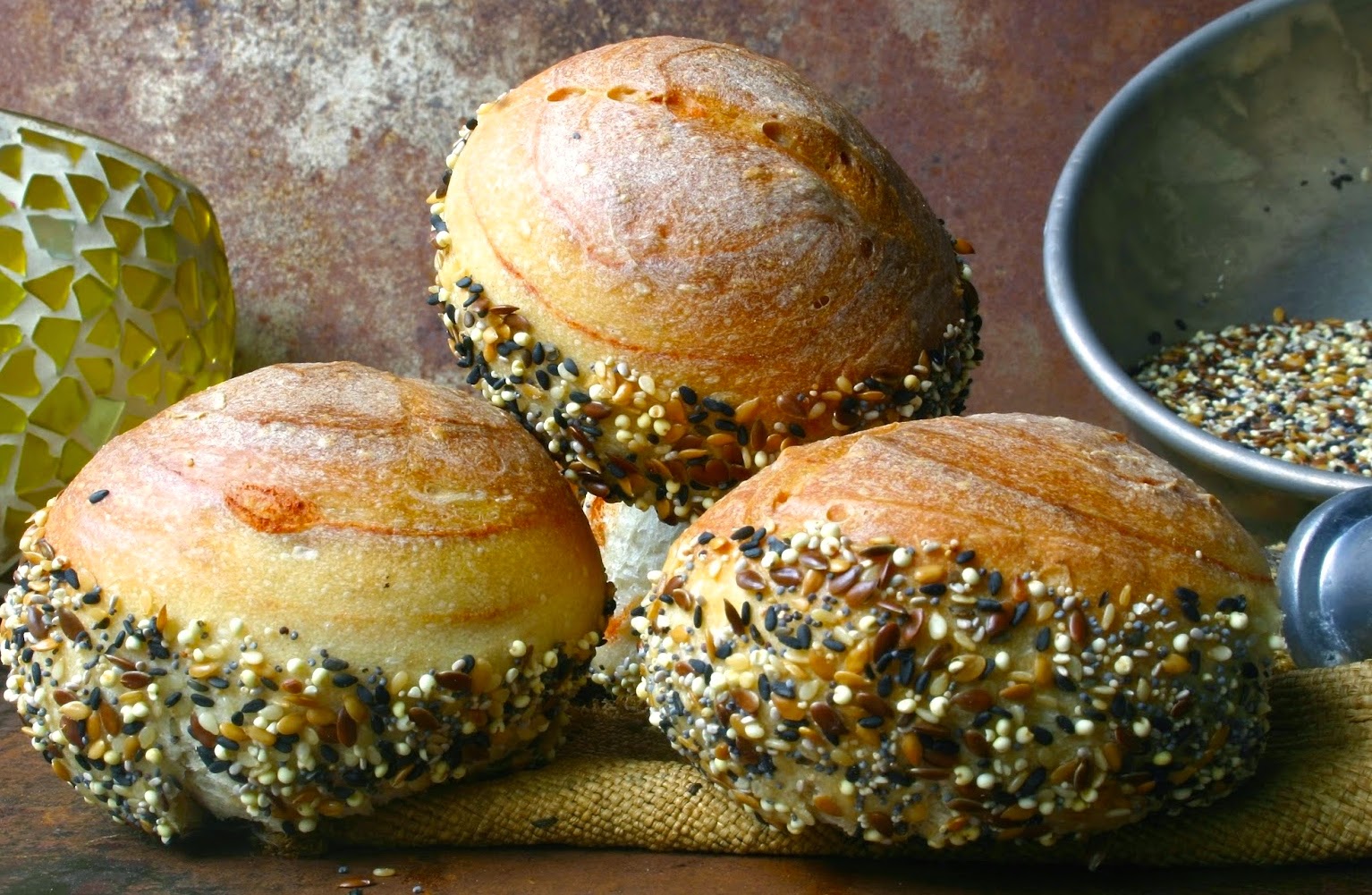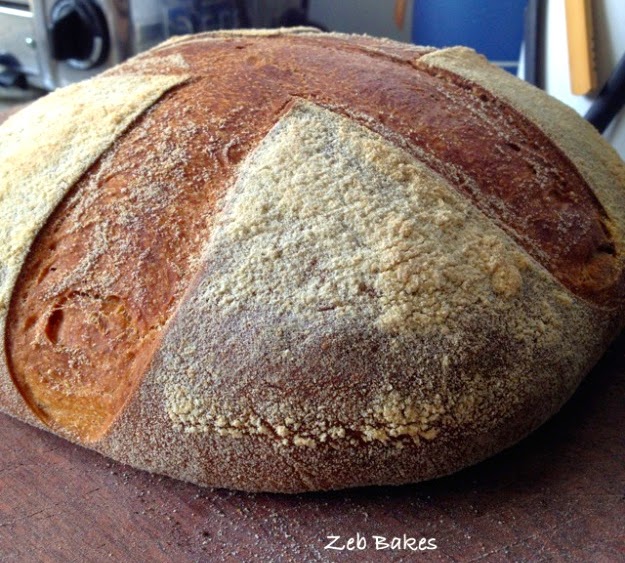Hier geht's zur deutschen Version dieses Posts
Dear baking friends who joined in my challenge to create
a Bread for the Knight with the Iron Hand:
YOU FILLED MY BASKET WITH 30 WONDERFUL LOAVES!!!
You thought about breads that were worthy of a famous knight from the middle ages, and, also, could please the palates of today's guests of
Schlosshotel Götzenburg.
Not only your enthusiasm and creativity is amazing - your comments about medieval knights in general, and Götz von Berlichingen in particular, are highly entertaining.
Götz von Berlichingen putting his iron hand to good use!
Some of you even tried to figure out what practical considerations might influence a pastry chef's decision on what kind of bread to choose - like using leftovers from the restaurant kitchen and easy availability of ingredients.
By and by, I will try to bake all of your breads (I have started already).
Also, I translated
all German recipes into English and vice versa. So, if you don't want to be at the mercy of Google-Translate (rather pathetic with bread formulas, but always good for a laugh!), please
contact me and I will send you the recipe.
 |
| Please, accept our gift! |
Dear management of Schlosshotel Götzenburg,
28 enthusiastic bread bakers from 9 countries, from Canada to Dubai, helped me fill a basket with 30 different breads worthy of a Götz von Berlichingen.
Please, accept our gift of recipes - so that your guests will find breads on the breakfast buffet that are a credit to your beautiful hotel (and not bland mass-produced loaves.)
SCHLOSSHOTEL GÖTZENBURG BREAD BASKET
1. Heritage wheats are not that easy to work with. The same is true for medieval bread grains that were around when Götz was fighting. But
Barbara Elisi (
Bread & Companatico) even coaxes a filigree crumb out of stubborn whole grain breads.
SICILIAN HERITAGE WHEAT BREAD FOR A GERMAN KNIGHT. I already baked her bread, with Maine heirloom wheat - it tastes fantastic!
2. With his hearty, moist bread,
Brian/Skibum (The Fresh Loaf) wants to supply hotel guests with a healthy dose of grains, seeds and fibers, and, also, make good use of leftover potato cooking water (from the restaurant kitchen):
IRON-HAND-12-GRAIN BREAD
3. Björn Hollensteiner (Der Brotdoc) presents his
GÖTZ VON BERLICHINGEN BREAD (with wheat and spelt) in
two delicious versions, as
round loaf:
and as break-away
flatbread. Considering Götz' one-handed-ness, the latter is, no doubt, a big plus!
(Björn has a bilingual blog, in German and English.)
4. With her hearty
POTATO-WHEAT-RYE BREAD FOR GÖTZ VON BERLICHINGEN,
Britta (
Brot vom Niederrhein) thought of the hotel guests' well-being, but, also, of possible
leftover usage in the restaurant kitchen.
With its high
potato content - cooked
and uncooked - her bread is nice and moist, and keeps fresh for several days. I made it, and it
tastes great! (
Please, contact me for the English translation of her recipe.)
5. Just back from China,
Che Foodzeit (
What's the time? It's FOODZEIT) had two goals in mind. His bread should symbolize the knight's iron hand (flax seed with a high iron content), and, also, "out-smell" his dirty mouth (with lavender flowers):
MIXED FLOUR BREAD FOR GÖTZ (
Che's blog is bilingual, German and English.)
6. Chorus (
Die Mehlkäfer) offers a light wheat bread to the medieval knight, appropriate for his noble status. She also adapted her post to
medieval language, and cautions:
"Refresh yourself, while you still can, rejoice and play the shawm, the little piece of bread in your hand could be you last. Enjoy it with appetite."
BISHOP'S BREAD FOR GOETHE'S GÖTZ (Please, contact me for the recipe in English)
7. Dabrownman (
The Fresh Loaf), baker extraordinaire of grain loaded breads, felt so inspired by Götz' life that he created
two loaves in his honor.
Hearty enough for the strongest knight, and, also, in view of the
sanitary habits of yore (and the call for a clean behind), baked with
high alcohol
black ale:
GÖTZ VON BERLICHINGEN ANCIENT AGE SOURDOUGH BREAD
8. To slice his
SWABIAN POTATO BREAD FOR GÖTZ OF THE IRON FIST, you don't need a sword, it's softened by the potato content, and reminiscent of the knight's Swabian origin. After making it twice - it advanced to the ranks of my favorite breads (
here's my take on it)
9. Dagmar Kern (
Brotecke) gave her mighty loaf a war-like name, and a matching fierce decoration to boot. Marked with a sword - and made
with
black ale, rye and spelt: just the right thing for a hungry knight and his guests!
SWORD BREAD FOR GÖTZ (
Please, contact me for the recipe in English)
10. Daniel Ronay (Facebook/Baking 101) believes a hothead like Götz should have a robust bread that matches his passionate nature.
His HOT CHILE-PEPPER LOAF FOR GÖTZ is seasoned with
chile peppers. (
Daniel doesn't have a blog, please contact me for the recipe).
- |
| Daniel Ronay's Hot Chile Pepper Loaf for Götz |
11. To "add a medieval tone" to his loaf,
Daniel Strachan (
Joy of Gluten) included a "bubbling, blurping porridge" in his
SPELT-PORRIDGE-BREAD FOR GÖTZ VON BERLICHINGEN
The trapped water in the porridge keeps the attractive breads moist for several days.
12. David Snyder/
dmsnyder, one of
The Fresh Loaf's best hobby bakers, finds that a medieval German knight would have been very lucky, indeed, to have a bread like this on his breakfast table:
70% RYE BREAD FOR A MEDIEVAL KNIGHT
13. Dietmar Kappl, master baker
at the renowned
Reichl-Bäckerei in St Marien (lucky Austrians!), shares some his wonderful breads in his
Homebaking Blog.
Even if authorities and clerics (which Götz despised, anyway) would have sneered at such a hearty rye loaf - my husband and I certainly didn't, it tastes excellent!
(Please, contact me for the recipe in English.)
KNIGHT'S BREAD "GÖTZ VON BERLICHINGEN",
14. He didn't find a medieval bread recipe during his research
, but
Don Sadowsky, author of the wildly popular
"Really? Authentic Bread?" unearthed a "tough as Krupp steel" Komissbrot from the trenches of Verdun.
It could have saved quite a few lives - if used as i
mpermeable shield against flying shrapnel!
1914 GERMAN ARMY KRIEGS-BROT
15. Eva Henningsen (
Kochpoetin) caters to the (long neglected)
soft side of Sir Götz. I baked her tender spelt brioches with fine orange-lime aroma - even the fiercest old warrior would have enjoyed a
KNIGHT'S BREAKFAST (Please, contact me for the recipe in English)
16. Freerk Bos (BreadLab) shares his very special relationship with Goethe's Götz - he was the first (and probably only) student who ever checked out this drama from the local library!
Little rolls, with a
paprika-chili spiral, dipped in seeds - I can't think of a prettier way Sturm und Drang became bread.
NO GÖTZ NO GLORY - HOT BLOODED BUNS:
17. Gary Turner (
The Fresh Loaf) did some research on food in medieval times. Whereas common people had to eat coarse rye and barley breads, only
finest wheat was good enough for the higher classes.
This is his delicious, mildly acidic
FIRST CLEAR FINE BREAD FOR SIR GÖTZ:
18. Ian Sandman's (
Mookie loves bread) four-legged kitchen helpers would have rather baked for the mysterious Black Knight
without hands (from the Artus legend), but could be persuaded that at least
one hand was needed to handle this rustic loaf!
IRON-HAND-CHALLENGE-BREAD - A PORRIDGE MICHE:
19. For health reasons
Janet Cook (
The Fresh Loaf) cannot eat her beautiful loaves herself, but that doesn't deter her from indulging in her bread baking passion: making her neighbors happy.
Inspired by medieval drinking habits, she added a barley mash to her wheat spelt bread.
BARLEY MASH BREAD FOR THE KNIGHT WITH THE IRON HAND (
Janet has no blog - please, contact me for the recipe!)
 |
| Janet's Barley Mash Bread for the Knight with the Iron Hand |
20. A piece of this bread in his chain mail pouch or saddle bag would have made a good meal for any knight hungry from pillaging.
Joanna's (
Zebbakes) loaf, made with a kefir levain,
is substantial enough for a forceful character like Götz:
KEFIR REMACINATA BREAD FOR A FORCEFUL CHARACTER
21. Josh/Golgi70 (
The Fresh Loaf) wants to sustain a knight on the road with a very nourishing loaf - full with berries, seeds - and bacon! It also makes good use of some kitchen leftovers:
A KNIGHT'S RYE
22 +
23. Jürgen Krauss' (
The Fresh Loaf) spelt bread comes in two variations, with
light or
green spelt. You can also choose between a purist version, or a loaf seasoned with nettle and fennel. Served with goat cheese the nettle version earned him his family's Annual Culinary Awards!
GÖTZ BROT - JÜRGEN'S TAKE, WITH LIGHT SPELT
GÖTZ-BROT - JÜRGEN'S TAKE, WITH GREEN SPELT
24. I wanted to use my favorite flours, spelt, einkorn, rye and barley
my own bread, and give it a medieval touch with a
millet porridge. My
bread guinea pig husband and I liked it a lot!
WORTHY OF A KNIGHT - KARIN'S GÖTZENBURG-BROT
25. Even in faraway Dubai
, Khalid/Mebake (
The Fresh Loaf) bakes with
freshly milled organic wheat, rye and spelt flours from Germany. His loaf tastes smoky, nutty, slightly acidic and caramel sweet, since it's made with a raisin soaker.
KHALID'S GÖTZENBURG BREAD
(My take on it
you find here)
26. Marcus/Wassisname (The Fresh Loaf) wondered, what kind of loaf he might offer Old Götz nowadays, and opted for a wheat bread with barley, oats and flax seed.
Everybody who tried it enjoyed his
GÖTZENBROT. And if anyone doesn’t like it? Well… thanks to Götz von Berlichingen, Marcus knows just what to say to those wimps!
27. Marion's (
Marion's Kitchenstories)
sourdough with whole wheat and rye berries has such a wonderful "bite" that it made the list of her top ten favorite breads.
(She posted in Dutch and English)
MARION'S WHEAT & RYE BERRY SOURDOUGH FOR A COURAGEOUS KNIGHT
28. No wonder that
Ninive (
Ninive Loves Life) took up the challenge to help fill the bread basket for Old Götz - her maiden name is Götze!
Her
WHOLE RYE BREAD FOR GÖTZ, made with coarse rye meal, beer and molasses, develops its good taste during long, slow fermentation. (
Ninive's blog is bilingual, German and English).
29. Sam Kargl (
Sam's Kitchen) wondered how traveling noblemen and their followers prepared their food when when they had no oven. Surely they would have brought a
kettle!
But if you aren't busy with plundering and pillaging you can also bake this hearty rye-wheat loaf in a regular oven, in a cast iron pot, or even without a "kettle". (
Please, contact me for the recipe in English)
KETTLE BREAD FOR GÖTZ:
30. Susan (
Facebook) bakes
this 1.8 kilogram heavy weight every week, and thinks a bread that she and her neighbors have enjoyed for years, should certainly please an old knight, too.
(Susan has no own blog - please, contact me for the recipe).
COUNTRY FRENCH BREAD FOR GÖTZ
 |
| Susan's Country French Bread for Götz |
COUNTRIES:
Germany: Britta, Che Foodzeit, Chorus, Eva, Brotdoc, Ninive, Dagmar
Great Britain: Jürgen, Joanna
Netherlands: Freerk, Marion
Austria: Dietmar, Sam
Sweden: Barbara
Switzerland: Daniel Strachan
Canada:
Brian
USA: Ian, Josh, Karin, Janet, Marcus, Gary, Don, Daniel Ronay, David, Dabrownman,
Susan
UAE/Dubai: Khalid
 |
| Good bye! |
 Hier geht's zur deutschen Version dieses Posts (folgt noch)
Hier geht's zur deutschen Version dieses Posts (folgt noch) 






















.JPG)
































